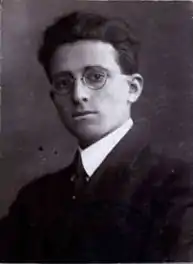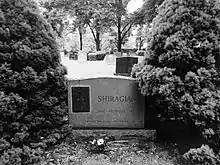Arshavir Shirakian | |
|---|---|
 Shiragian's passport photo in 1919 | |
| Born | 1900 |
| Died | April 12, 1973 (aged 72–73) |
| Resting place | Hackensack Cemetery 40°54′31″N 74°02′00″W / 40.90872°N 74.033301°W |
| Known for | Assassinating Cemal Azmi, Said Halim Pasha, Behaeddin Shakir, and Vahe Ihsan |
| Political party | Armenian Revolutionary Federation |
Arshavir Shirakian (also Shiragian, Armenian: Արշաւիր Շիրակեան; January 1, 1902[1] or 1900 – April 12, 1973) was an Armenian writer and assassin who was noted for his assassination of Said Halim Pasha and Cemal Azmi as an act of vengeance for their roles in the Armenian genocide. His memoirs, It was the Will for the Martyrs (Կտակն էր Նահատակներուն), is a description of his life during the Armenian genocide and the Operation Nemesis.
Life
Arshavir Shirakian was born in Constantinople, Ottoman Empire, in 1900.[2] Shirakian grew up around many members of the Armenian Revolutionary Federation. During the Armenian Genocide, Shirakian was entrusted the job of smuggling weapons and delivering secret messages amongst party members.[2] Shirakian would describe in his memoirs that during those days, there were many hate rallies against Armenians and that many Armenian establishments were vandalized such as the Tokatlian Hotel.[3][4]
Operation Nemesis
Arshavir Shirakian's first target was assassinating Armenian Vahe Ihsan (Yesayan). According to his memoirs, Vahe Ihsan was "a traitor who was despised by his countrymen, his relatives, and eventually by his own children" and "helped to draw up the list of prominent Armenians who were arrested and deported in 1915."[4] Shirakian assassinated Ihsan on March 27, 1920, in Constantinople.[2]
Shirakian was given the task to assassinate Said Halim Pasha while he was in exile in Rome, Italy. Shirakian took up residence in a house on 28 Via Cola di Rienzo in Rome.[3] On December 5, 1921, Shirakian assassinated Said Halim Pasha while he was in a taxi on the home on Via Eustachio.[4][5][6][7]
Shirakian, along with Aram Yerganian, was later given the task to assassinate both Cemal Azmi and Behaeddin Shakir, who were in Berlin.[2] On April 17, 1922, Shirakian and Yerganian encountered Azmi and Shakir walking with their families at the Uhlandstrasse street.[8] Shirakian managed to kill only Azmi and wound Shakir. Yerganian later ran after Shakir and managed to kill him with a shot to his head.[2][3]
Later life

Arshavir Shirakian eventually married his wife Kayane and moved to New York in 1923, where they had a daughter, Sonia. He also was active in public life in the New York/New Jersey area and its Armenian community. He published his memoirs in 1965 entitled Ktakn er Nahataknerun (translated in English as It Was the Legacy of the Martyrs). The memoirs were eventually translated into French (La dette du sang, 1982 and 1984), English (The Legacy, 1976, by Sonia Shiragian) and Italian (Condannato A Uccidere: Memorie di un Patriota Armeno, 2005, by Vasken Pambakian).[9] A resident of Leonia, Shirakian died in 1973 at the age of 73 at Englewood Hospital in Englewood, New Jersey.[2][10] He is buried in the Hackensack Cemetery in New Jersey. His daughter, Sonia, currently lives in South Carolina with her daughter Elizabeth Poston.
He is recognized and honored as a national hero by Armenians.[11]
References
- ↑ Ssdi. "Ancestry.com". Ancestry.com.
- 1 2 3 4 5 6 Berberyan, Nazaret (April 13, 2010). ՏԱՐԵԴԱՐՁՆԵՐ- Արշաւիր Շիրակեան Հայ ժողովուրդի Արդարահատոյց Բազուկը. Asbarez (in Armenian). Retrieved May 25, 2013.
- 1 2 3 Derogy, Jacques (1990). Resistance and revenge: the Armenian assassination of the Turkish leaders responsible for the 1915 massacres and deportations. Transaction Publishers. ISBN 978-1-4128-3316-5.
- 1 2 3 Arshavir Shiragian, The Legacy memoirs of an Armenian Patriot, Hairenik Press 1976, p. 108
- ↑ Horne, edited by Robert Gerwarth, John (September 27, 2012). War in peace : paramilitary violence in Europe after the Great War. Oxford: Oxford University Press. ISBN 978-0-19-965491-8.
{{cite book}}:|first=has generic name (help)CS1 maint: multiple names: authors list (link) - ↑ Newton, Michael (2012). Age of Assassins: A History of Conspiracy and Political Violence, 1865–1981. Faber & Faber. p. 273. ISBN 978-0-571-29046-8.
- ↑ "The Punishment – of those responsible for the Armenian Genocide". HyeEtch Armenian History. Archived from the original on December 11, 2006. Retrieved May 26, 2013.
- ↑ "Two 'Young Turks' Murdered in Berlin" (PDF). New York Times. April 19, 1922. Retrieved May 25, 2013.
- ↑ "Arshavir Shiragian Memoir Published in Italy". Asbarez. September 30, 2005. Retrieved May 25, 2013.
- ↑ "Shiragian, 73, Dies; An Armenian Hero", The New York Times,April 16, 1973. Accessed October 17, 2020."Leonia, N. J., April 15—Arshavir Shiragian, a retired dealer in Oriental rugs, who, as a young man, killed three prominent Turks in reprisal for the massacre of Armenians in World War I, died Thursday In Englewood Hospital. He was 73 years old and lived at 530 Grandview Terrace."
- ↑ Karentz, Varoujan (2004). Mitchnapert = Citadel : a history of Armenians in Rhode Island. New York: IUniverse, Inc. ISBN 0-595-30662-4.